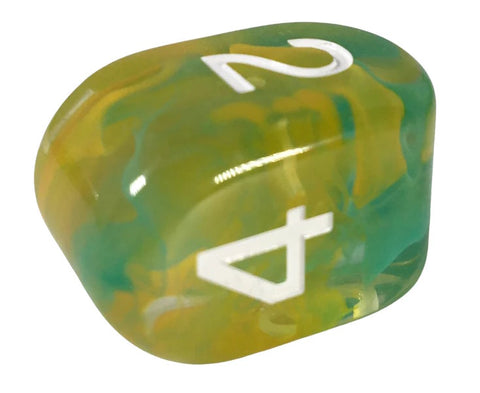Packs of Arch'd4 - Roll Again Dice
Bringing high-quality products to the TTRPG community!
Old tetrahedral d4s are hard to pick up, roll, and read. Be different with the Arch’d4™ — the roly-poly number tumbler and the next evolution of the four-sided die. A true game changer!

The Arch'd4™ is available in all of our sets of 7, sets of 15, as singles, and in packs.
The Evolution of the Four-Sided (d4) Die: A Historical Journey
From the temples of ancient civilizations to the tabletops of modern gamers, the four-sided die — or d4 — has rolled through thousands of years of human history. Its story reflects our timeless fascination with chance, strategy, and storytelling. More than a simple gaming tool, the d4 stands as a small but powerful symbol of human creativity, mathematics, and the enduring joy of play.
Ancient Origins:
For thousands of years, dice have captivated players across nearly every ancient civilization. The Mesopotamians, Egyptians, Greeks, and Romans all enjoyed games of chance that relied on these small yet powerful symbols of fate. Early dice ranged from simple carved sticks and stones to finely crafted pieces made of bone, ivory, and precious metals.
Among these relics were early four-sided dice, precursors to the modern d4. Some featured triangular or pyramid-like shapes, while others bore markings that hinted at outcomes from one to four. These ancient creations reveal humanity’s enduring fascination with randomness and probability—centuries before mathematics gave us a language to describe them.

Unusual shapes of d4: crystal or teardrop, barrel, knucklebones
Medieval and Renaissance Europe
During the Middle Ages and the Renaissance, dice games remained a favorite pastime among nobles and commoners alike. Whether in taverns, courts, or bustling marketplaces, people used dice for gambling, divination, and entertainment, continuing a tradition that had already spanned millennia.
Although six-sided dice dominated the era, historical records and surviving artifacts show that four-sided dice also made appearances. These were often carved from bone, horn, or wood and inscribed with symbols or numbers to represent various outcomes. Their craftsmanship reflected both artistry and practicality—serving as tools of chance as well as objects of beauty in an age when games mirrored the unpredictability of life itself.
The Birth of Modern Gaming:
The 20th century saw the emergence of modern tabletop gaming, fueled by the popularity of board games, role-playing games (RPGs), and wargaming. Companies like TSR (Tactical Studies Rules), founded by Gary Gygax and Dave Arneson, played a pivotal role in shaping the landscape of tabletop gaming with their iconic Dungeons & Dragons (D&D) RPG.
Tetrahedron d4s (from left to right):
top-read, bottom-read, bottom-face, truncated-top-read, wedge.
In the early 1970s, TSR introduced the first commercially available d4 dice as part of their D&D product line. These dice featured the familiar tetrahedral shape, with each face numbered from one to four. The d4 became an essential component of RPGs, used to determine outcomes such as damage dealt by weapons, spells, or other game mechanics.
Expansion and Innovation:
As tabletop gaming continued to grow in popularity, so too did the demand for diverse and visually appealing dice. Manufacturers began experimenting with different materials, shapes, and designs to cater to the preferences of gamers and collectors.
Over the years, the d4 dice has undergone various iterations and innovations. From traditional plastic dice to artisanal creations made from metal, gemstones, or exotic materials, players now have a wide array of options to choose from. Specialized d4 dice, such as spindown dice with sequential numbering or oversized novelty dice, have also become popular for specific gaming purposes or as collector's items.
Repeating polyhedrons: Octahedron (1-4 twice), Dodecahedron (1-4 thrice)
Beyond Gaming:
While the d4 dice is synonymous with tabletop gaming, its utility extends beyond the realm of games. Mathematicians, statisticians, and educators use d4 dice for probability experiments, simulations, and teaching purposes. The simplicity and fairness of the d4 make it an invaluable tool for exploring concepts like randomness, chance, and statistical analysis in a hands-on manner.
In addition to its practical applications, the d4 dice holds cultural significance as a symbol of creativity, imagination, and social interaction. Gaming communities around the world celebrate the d4 as a fundamental element of their shared hobby, fostering friendships, storytelling, and collaborative experiences.
Conclusion
From its ancient origins to its modern incarnations, the four-sided (d4) die has traversed the annals of human history, leaving an indelible mark on culture, mathematics, and leisure activities. Its evolution from simple implements of chance to iconic gaming artifacts reflects humanity's enduring fascination with randomness, strategy, and storytelling.
As tabletop gaming continues to evolve in the digital age, the d4 dice remains a timeless symbol of camaraderie, creativity, and adventure. Whether used to slay dragons in fantastical realms or explore mathematical principles in classrooms, the humble d4 continues to captivate and inspire generations of gamers and enthusiasts around the world.
With all these different shapes, we believe that the Arch'd4 is the best in terms of practicality, readability, rollability, and pleasant to view. Pick up some or today! We're sure you'll agree.
.




